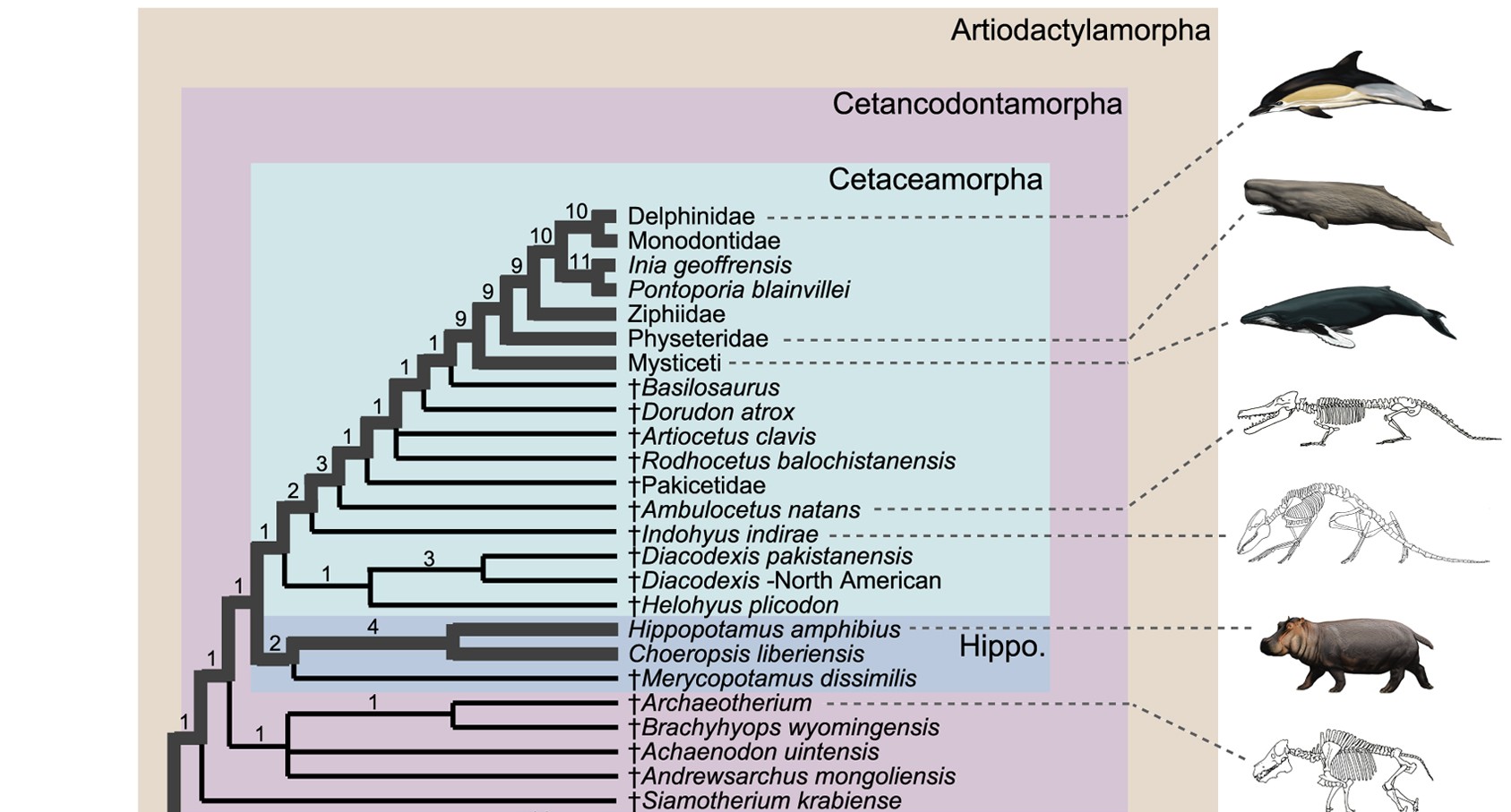MultipleOrganisms.Net 
Photo courtesy of tibchris
Classification
Supergroup: Unikonta
Kingdom: Animalia
Phylum: Chordata
Subphylum: Vertebrata
Class: Mammalia
Order: Cetacea
Suborder: Mysticeti
Family: Balaenopteradae
Genus: Balaenoptera
Species: Balaenoptera musculus
Courtesy of Wikipedia Commons
Closest Terrestrial Relatives
Artiodactyla
The hippopotamus (Hippopotamus amphibius) is molecularly the closest living terrestrial relative of Balaenoptera musculus and all other marine mammals. Hippopotamuses are members of the order Artiodactyla. The artiodactyls are comprised of hippopotamuses, pigs, giraffes, deer, camels, bovids, peccaries, and tragulids. Artiodactyls are grouped together because of their hoofed feet which bear the weight on the third and fourth toe. The second and fifth toes are either rudimentary or absent, and the first toe is almost always absent.
Molecular Similarities
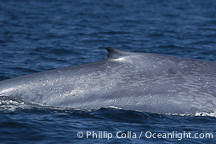 Analysis of the mitochondrial gene cytochrome b determinded that artiodactyls and cetaceans are sister groups. Later studies supported the claim that cetaceans originated within Artiodactyla. Further analysis of nuclear and mitochondrial sequences points to a sister-group relationship between hippopotamuses and the cetaceans. In addition, comparisons between the milk protein genes beta-casein and kappa-casein also validate the close relationship between hippopotamuses and cetaceans. The evolutionary rate of mitochondrial genes in the cetaceans are faster than that of the artiodactyls. The evolutionary rate of the same genes in hippopotamuses are also faster than those in the other artiodactyls, but not as fast as the genes in the cetaceans. Thus, the proposed hippopotamid-cetacean clade has an accelerated evolutionary rate which separated them from the artiodactyls, and the cetaceans specifically have an accelerated rate of evolution that separated them from the hippopotamuses. It is believed that the cetaceans evolved from the artiodactyls 45 million years ago. For evolutionary adaptations of the Balaenoptera musculus, see Adaptations.
Analysis of the mitochondrial gene cytochrome b determinded that artiodactyls and cetaceans are sister groups. Later studies supported the claim that cetaceans originated within Artiodactyla. Further analysis of nuclear and mitochondrial sequences points to a sister-group relationship between hippopotamuses and the cetaceans. In addition, comparisons between the milk protein genes beta-casein and kappa-casein also validate the close relationship between hippopotamuses and cetaceans. The evolutionary rate of mitochondrial genes in the cetaceans are faster than that of the artiodactyls. The evolutionary rate of the same genes in hippopotamuses are also faster than those in the other artiodactyls, but not as fast as the genes in the cetaceans. Thus, the proposed hippopotamid-cetacean clade has an accelerated evolutionary rate which separated them from the artiodactyls, and the cetaceans specifically have an accelerated rate of evolution that separated them from the hippopotamuses. It is believed that the cetaceans evolved from the artiodactyls 45 million years ago. For evolutionary adaptations of the Balaenoptera musculus, see Adaptations.
Closest Marine Relatives
The Cetaceans
Balaenoptera musculus are classified in the family of cetaceans. Cetaceans include all whales, dolphins, and porpoises. The obvious similarity lies in their habitat location: the ocean. No mammals other than the cetaceans live entirely in marine environments. They have little to no hair, but instead have blubber. The forelimbs seen in terrestrial mammals evolved into fins, which have bones in them.
Mysticeti
The cetaceans are divided into Odontoceti and Mysticeti. Odontoceti includes dolphins, whales, and porpoises with teeth, whereas the Mysticeti exclusively has whales, all of which filter feed with a structure known as a baleen.
Balaenopteridae
These whales are commonly known as "rorquals," which is derived from a Norwegian word meaning "furrow whale." These whales have throat pleats which help capture large volumes of food. Balaenopteridae is divided into two subfamilies: Balaenopterinae, containing the genus Balaenoptera; and Megapterinae, containing the genus Megaptera and its lone species Megaptera novaeangliae, commonly known as the humpback whale.
Humpback Whale: Courtesy of NOAA
Characteristics separating the humpback from Balaenoptera are their huge pectoral fins that grow to almost one third of the whale's total body length. In addition, humpbacks have serrated tails, a trait exclusive to them in their family. The genus Balaenoptera contains eight species (the eighth species, Balaenoptera omurai, once thought to be a pygmy form of Balaenoptera brydei (Bryde's whale), has recently been proposed). It also contains the minke whale and Antarctic minke whale, fin whale, sei whale, and Bryde's whale.
Phylogenetic Tree
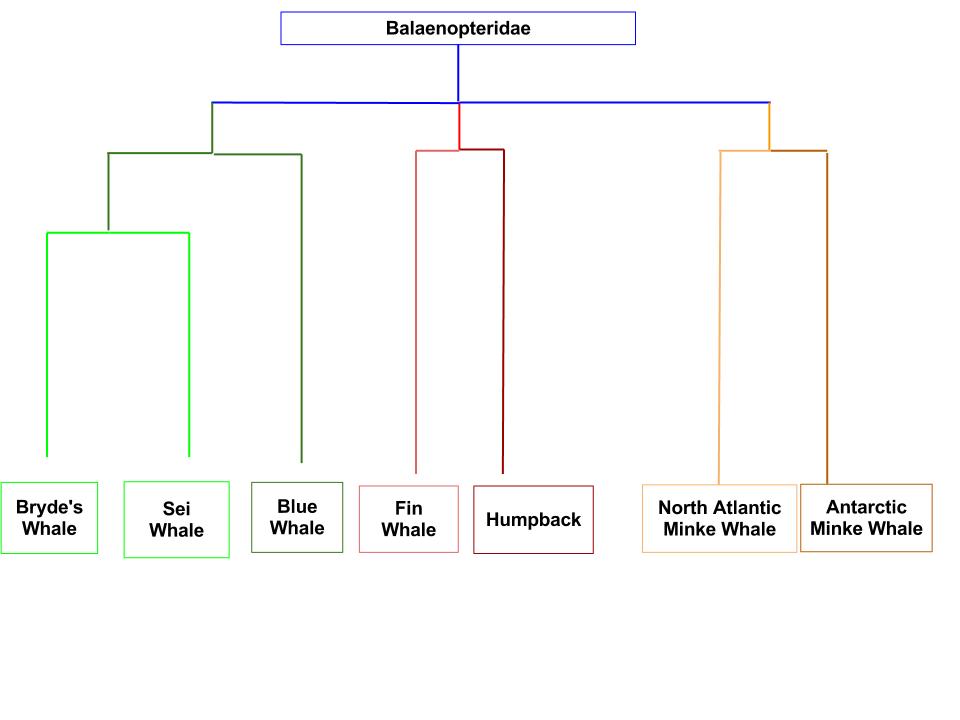
Chart by Riley Olson
The tree above is based on the complete mitochondrial DNA sequences and SINE (short interspersed elements: these are reverse transcribed RNA molecules) insertion data before proposed omura whale species. This tree places Balaenoptera musculus closest to Bryde's whale and Balaenoptera borealis (Sei Whale). The Bryde's whale and sei whale are very similar morphologically with the only distinguishable difference being three ridges on the head of the Bryde's whale where the sei whale has only one. These whales, having the long and pointed snout, have a similar skull structure and dorsal fin shape to the blue whale.
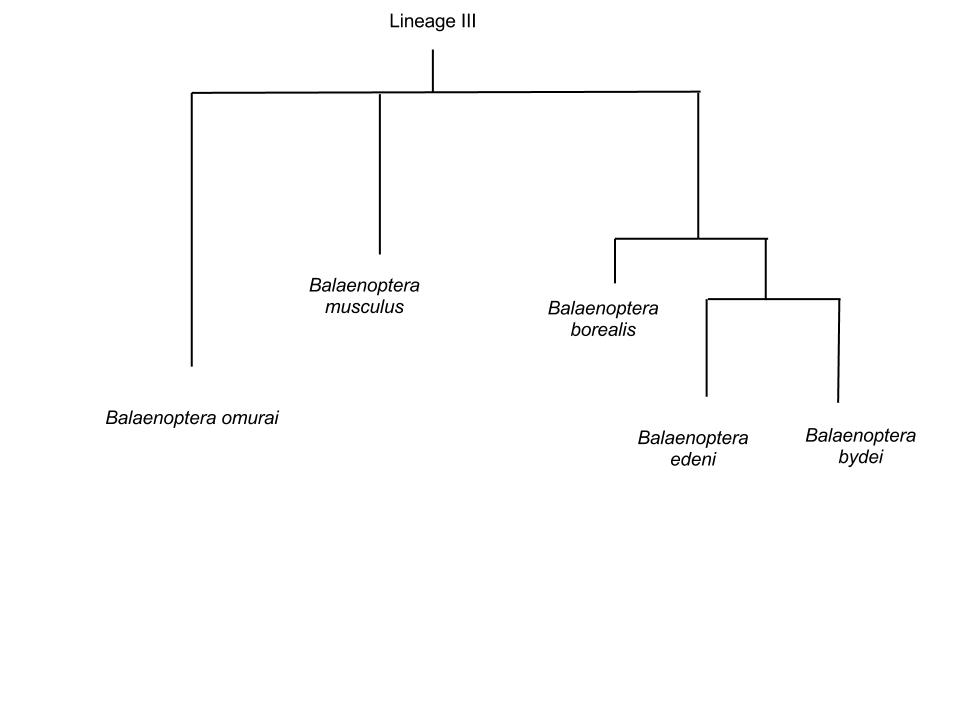
Chart by Riley Olson
This second tree, based on a 2006 comparsion of mitochondrial DNA and SINE insertions, recognizes the omura whale as a species. It categorized Balaenopteridae and Estrichtiidae into 4 lineages. Balaenoptera musculus is in Lineage III, which also includes the sei whale, Bryde's whale, omura whale, and the eden whale, Balaenoptera edeni. Interestingly, the data places the omura whale closest to the blue whale. Little research has been done on the omura whale, but sightings suggest it has a dorsal fin and skull shaped similarly to the Bryde's, sei, and blue whale. Balaenoptera edeni is also very similar to Bryde's whale morphologically.
Subspecies
There are three proposed subspecies of Balaenoptera musculus. Due to a lack of genetic markers separating the subspecies, the taxonomic organization is not complete. Groupings are established loosely based on geographic locations, size, and acoustic calls. They go as follows:
| B. musculus musculus | Blue whales of the Northern Hemisphere. First described by Linnaeus, these whales inhabit the North Atlantic and the North Pacific. | 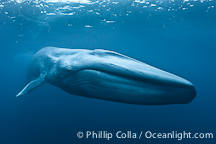 Blue whale photos by Oceanlight.com |
| B. musculus intermedia | Commonly known as the Antarctic Blue Whale. These whales, once highest among the subspecies in abundance, have dwindled in numbers. It is estimated that less than 1 percent of the pre-whaling population, 240,000, is alive today. These are the largest of the blue whales with sizes reaching up to 33 meters in length. | 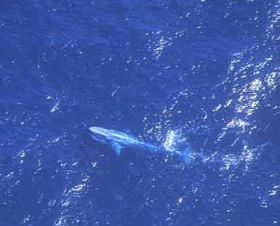 Courtesy of the Australian Government Dept. of Sustainability, Environment, Water, Population, and Communities |
| B. musculus brevicauda | Commonly known as the Pygmy Blue Whale. B. musculus brevicauda, the name brevicauda means "short tail," referring to the shorter distance between the dorsal fin and the fluke. They have shorter baleen plates, larger heads, and are known to have blue-grey blots throughout the skin. Unlike the other subspecies that have one single sound unit, pygmy blue whales have 2-4. |  Courtesy of Jeffrey and Wikipedia Commons |
Overview of taxonomy
Back to Top
Eukarya
- Endomembrane System
- Multicellularity (with many exeptions)
- Multiple, linear chromosomes
- Cell division by mitosis
- Genes have introns
- No peptidoglycan in cell walls
- Passiflora eduli
- Example-Moose (Alces alces)
Unikonta
Encompasses amoebozoans, gymnamaeba, entamoeba, and opisthikonts
Flagellum at some stage of development
Opistikonts have flat cristae in mitochondria
Features the animals and fungi
Example- Morchella esculentoides
Capable of locomotion (with exceptions-the sponges)
Heterotrophic and detrivores
No cell walls
Often held together by collagen and intercellular junctions
Gametes do not undergo mitosis
Example-Red tailed hawk (Buteo jamaicenis)
Example-Differential Grasshopper (Melanoplus differentialis)
Back to Top
Chordata
Triploblast (embryo has 3 types of germ layers: ectoderm, endoderm, and mesoderm)

Coelom (fluid-filled body cavity)
Bilateral symmetry
Notochord
Endoskeleton
Complete digestive track
Dorsal, tubular nerve chord
Thyroid gland
Pharyngeal pouches
Post-anal tail
Example-Smallmouth Bass (Micropterus dolomieui)
Back to Top
Vertabrata (Or Craniata)
Possesses a backbone (not in hagfish)
Possess cranium
Example-Emu (Dromaius novaehollandiae)
Back to Top
Mammalia
Warm-blooded
Hair or fur
Breath through lungs
Mammary glands
Internal fertilization
Example- North American Beaver (Castor canadensis)
Back to Top
Cetacea
Live in marine environments
Spine is flexible vertically but not horizontally
Fluke (tail) moves up and down, not sideways as fish tails do
Stomachs have multiple compartments
Placental
Example- Spinner dolphin (Stenella longirostris)
Back to Top
Mysticeti (Common name-Baleen whales)
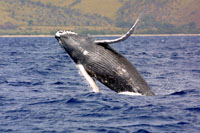 Humpback Whale: Courtesy of NOAA
Humpback Whale: Courtesy of NOAA
Feed with baleen instead of teeth
Shortening of the neck
Enlargement of the head and body size
Back to Top
Balaenopteradae (Common name-Rorquals)
Single blowhole and dorsal fin
Throat pleats
Elongated flippers
Gestation lasts approximately 12 months
Where do we find these things?
04/22/2012 08:11 PM

